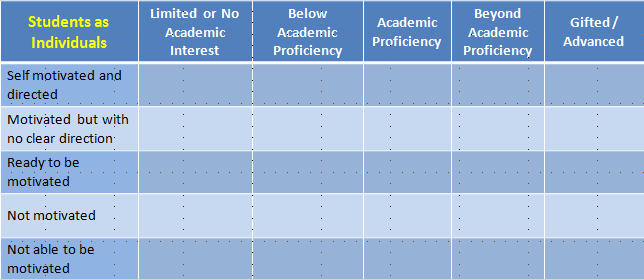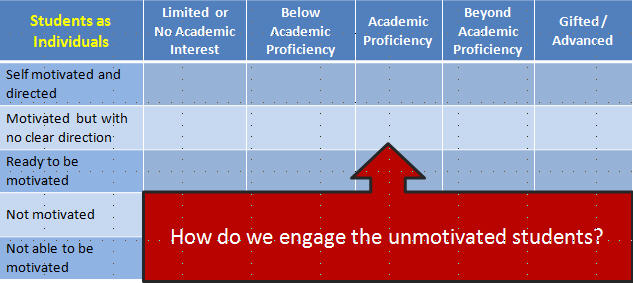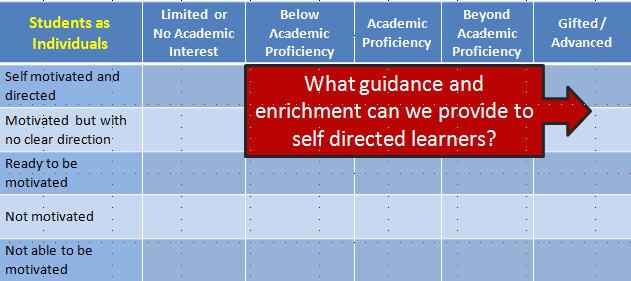Does equal opportunity for all mean that we are all the same? Does it mean that high school students share the same goals? Travel the same academic path? Have the same abilities and interests? Of course not. It is time that the debate on education reform focus on the student as an individual and not merely an undifferentiated member of a racial, ethnic or socio-economic sub-group.
When we examine the life of any one student, we will most likely find within that story a deep and meaningful history filled with sorrow and joy, strife and struggle of some kind, as well as set backs and opportunities. What seems to be lost from the current education debate is a discussion of the student as an individual. The policy makers speak in broad terms about sub groups as if in a country as diverse as the United States these subgroup definitions still have real meaning. These broad labels, although convenient, are misleading. They meld together in an undifferentiated classification the richness and nuance of so many distinct personalities, lifestyles and perspectives. These 20th century labels, once important in the era when counting and quotas were used to set policy, have created a unfortunate paradigm in education that minimizes the individuality of the American student of all races, genders and cultures.
Motivation Continuum
America is a great country. A major source of that greatness comes from the diversity of the population. But mention the term diversity and we first think about race, ethnicity, culture or gender. We are losing sight of the diversity of individual personality in this country while at the same time focusing too much on these divisive and soon to be irrelevant broad racial, ethnic and gender labels. Take 15 minutes and talk to a student in high school. The conversation may reveal a child that is disinterested in education, unmotivated and struggling. Talk to another student and you may find a child that is so future focused that they are searching for every opportunity, advancing along a self directed path to a future they have long envisioned for themselves. Talk to another student and they may be comfortable in school, although challenged by the work load but enjoying the academic ride not sure where it may lead.
Classifying these students by race, ethnicity or gender does not provide any insight into the best ways to reach them with the right guidance and instruction. Does it matter if the unmotivated student is White, Black, Hispanic, Gay or other? Clearly it shouldn’t. But unfortunately it does today. And because of this reliance on these outmoded 20th century broad labels, the education reform debaters are not discussing the needs of individual students. So we create policies that attempt to close an achievement gap based on 20th century definitions of required knowledge and 20th century categorizations of students that provide no insight in how to teach or reach them.
It may be more valuable to classify students along a continuum of motivation than it would to adhere to classifications solely based on ethnicity. A “Motivation Continuum” would cut across race, class, and culture. Gaining an understanding of the underlying motivation and future vision of a student might provide key information critical to the development of strategies to engage and encourage them on their individual educational journey. Measuring motivation is hard. Self reports are not precise and assessment is politically difficult. So instead we use race, ethnicity or gender to classify students because it is easy and has become politically accepted in education circles. But it is time for a new framework to be developed that considers the student as an individual with distinct, individualized motives and abilities. A hastily considered framework is offered below.
The Student as Individual Framework
The “Student as Individual Framework” proposed is not intended to describe large social groups. The framework recognizes that within any socio-economic group there is much diversity and in many instances there may be more commonalities among members of different races, ethnicities and cultures. This framework is not intended to describe any or all students. It is instead offered as a paradigm that would encourage a shift in focus from the achievement gaps of large undifferentiated social groups to the needs of the student as an individual learner.
Review the testing data from nearly any city in the US. Within schools that are generally under-performing you will find students that have beaten the odds, not succumb to institutionalized low expectations, demonstrating their abilities by outscoring their peers. The framework above can capture and classify these students in a way that would allow for a meaningful discussion about enrichment programs, school choice or other intervention that would enhance and focus their self directed energies.
The framework can also be used to describe unmotivated students in the wealthiest suburbs or the poorest inner city schools. Clearly moving students from the lower left portion of the framework’s matrix to the upper right is the most desirable path. But pragmatic action has to be the priority. Well intentioned broad policy may marginally move sub-groups forward while leaving behind those most able to contribute to themselves, their communities and this nation.
As I talk with students, I am struck not by the color of their skin, the language spoken at home or the income of their parents. What seems to come out most in a conversation with young students is their relationship with the world around them, their curiosity to explore that world, and their relationship to their own future. Are they curious? Do they question? Are they passionate about something? Do they have a vision for themselves? Are they followers or are they leaders?
From Framework to Individualized Instructional Strategies
The framework attempts to understand these attributes and to classify them into convenient categories that can be used to discuss educational strategies intended to move individual students forward.
- For those not yet proficient onward to proficiency.
- For those that are not motivated onward promoting self motivation.
- For those with advanced proficiency onward to greater challenge and development
- For those with limited interest in academics onward to more meaningful alternatives
Consider that each student is taking a distinct journey not necessarily to the same destination. But the educational trajectory will hopefully be uniquely suited to the student’s interest and ability. The educators along the way serving as guides to help them attain the needed knowledge and skill to progress forward.
Motivation and Drive. Is it reasonable to assume that it is easier to guide and coach the self motivated student than it is to encourage a chronically unmotivated student? What do our schools offer those students that have “checked out“ mentally from the classroom, showing no motivation to participate in the learning process? The opposite question is as important. What are schools doing for those students so self directed and driven that they are finding academic success in school communities where failure is the norm?
The Student as Individual Framework also considers the academic ability of the individual. This is potentially politically incorrect because it suggests a truism that many prefer to ignore. Some people are more academically capable than others. This is a phenomenon that cuts across race, ethnicity and culture. The ability to understand math concepts, the nuance underlying great literature or the scientific constructs of the world around us is not universal. There are those that quickly grasp the method, meaning or principle of the subject matter while others will forever struggle to get to basic familiarity with the same. This is a fact of life. Equality of opportunity does not mean that we are all of the same ability.
In the future world, as described in a very worthwhile book called 21st Century Skills, Bernie Trilling and Charles Fadel describe a new paradigm for learning that include skills well beyond those traditionally measured on standardized tests or taught in our schools today. The authors provide compelling arguments that the current K-12 school paradigm needs to be reviewed and possibly re-thought. In the new globally connected 24/7 world, education must include multi-cultural exposure, engaging team oriented work, and technology enabled curriculum which offers the promise of differentiated instruction to support the individual learning styles of our students.
Consider the following questions as they are plotted on the Student as Individual Framework.
Shifting focus from race and socio-economics to underlying student motivation is more difficult when debating education policy and reform. Math skills can be tested easily with multiple choice questions. English proficiency can be also tested with well researched questions on reading comprehension or vocabulary. But how can you accurately test and measure a student’s desire to learn or their interest in academic pursuits? Is motivation a better predictor of success in college and career than raw skill assessed in a series of multiple choice questions given in a multi-hour exam in a setting far removed from the requirements of college or the world of work. Understanding how motivated a student is in their learning should provide valuable insight and guidance to teachers and lesson planners. It is well known that the more engaged the student is in the process of learning the more they learn. Moving away from the convenient and often times damaging 20th century concept of the achievement gap toward a focus on individual progress will change the debate in ways that will positively impact students of all types. It is time we start to focus on individuals and not sub-groups.






